The online clothing sector, which includes apparel, accessories, and footwear, is valued at over $775 billion. Data published on Shopify projects the sector to breach $1.2 trillion by 2025.
Insights shared on Forbes indicate that an online clothing boutique averages about $6,013 per month. This means that running an online clothing store is a great side hustle or a solid full-time business.
These factors shared above mean that more than ever, a great opportunity exists for entrepreneurs who want to claim their market share in this lucrative ecommerce sector.
A Complete Guide on Starting Virtual Clothing Store Without Inventory
Summary and Overview
Advantages of Starting an Online Store without Inventory

Advantages Overview
Low Financial Risk
As a beginner, how much grip you have on the financial risk is a make or break. Starting an online clothing store is about starting a store without your own inventory. This enables retailers to focus on marketing their online store offering sterling. This makes the apparel sector one of the sectors with the lowest barriers of entry.
How Much Does It Cost To Start An Online Clothing Store Without An Inventory?
Let’s tally up the cost of starting an online clothing store without inventory. In the table below we look at the bare minimum that you need to get to an online clothing boutique set up and going.
Domain Name Registration | $9.95 per month | With Bluehost |
| Logo Design | $5 | On Fiverr |
| Shopify | $25.5 per month | Shopify |
| Total Required to start an online clothing store | $40,45 first month $35,45 every month after |
No Inventory Warehousing Costs
With this model you also save on storage costs since you have no inventory to keep. Concerns such as inventory storage management as well as order fulfilment are handled by your supplier.
Wide Product Range
With capital for procuring inventory as well as inventory storage and management out of the way, you have the flexibility to take up a wide range of products without being limited by upfront costs. This widens your market significantly by enabling you cater to different preferences, market segments while enhancing your store’s repertoire and sales prospects.
Flexibility and Scalability
One very important aspect of running a business is pivoting. This is what Amazon did. Amazon changed their business model three times within 2 years and it’s on the third attempt that Jeff Bizos found the winning formula.
As you are starting out, you need the flexibility to drop products that are not giving your traction with the market and pivot to products that sell and are good for your niche. Without the intricacies and nightmares of inventory management costs and storage an online clothing store without inventory gives you this advantage.
This also allows you to scale your business.
Focus on Marketing and Customer Experience
The other advantages of this model and approach to online apparel retailers is with inventory management dynamic off the way, you will have a pronounced focus on marketing and customer experience. You will also be in position to hone your marketing acumen, grow your customer base and build your brand.
Global Reach
A drop shipping approach to running an clothing store online makes global reach and accessibility within your reach. The approach enables you to meet the needs of customers from far afield around the globe without worrying about the intricacies of shipping and logistics. This phenomenally expands your customer base and revenue streams.
Reduced Operational Complexity
One last key benefit of running an online clothing store without inventory is that inventory management eliminated from your workflow takes away about 80% of the grind that goes into starting and sustaining a clothing retail business. This will enable you to enhance your efficiencies and focus more on business development.
This business model therefore provides a low risk entry point into ecommerce and particularly the lucrative apparels sector.
Understanding the No-Inventory Business Model

What is Drop shipping and how does it work?
The best way to explain drop shipping and how it works is to paint a scenario.
Imagine you are running a clothing store called “Fashion Frenzy”. You don’t have products of your own and then make an arrangement with clothing manufacturers that you will promote their products in your shop.
So, on your online store you put up products and product details such as product titles, description, pricing and pictures, etc. Then when a customer purchases the product from your online store, your website notifies the manufacturer about the purchase and suppliers them with the order details.
The manufacturer receives their portion of the money and ships the product to the customer. The customer receives the product and the order is fulfilled. And you’re just made a profit of about 10% – 30% on the sale of a product you did not manufacture or own. That’s how drop shipping works.
How to Research and Select a Good Niche for Online Clothing Store
Finding a good niche for your online clothing store is one great important aspect of starting a profitable online venture. Your choice here can make it or break it but the good thing with drop shipping is that, as we mentioned earlier, it’s easy to pivot here as you don’t have physical goods to worry about.
That said, here are some crucial principles of finding the best online clothing store niche.
Start with your interests and passion
Creating a successful online venture takes a lot of work, diligence and consistency. This can be great fun however if you are doing what you like. If you choose a niche related to your passion and interest you will find your work a whole easier and the burden lighter. Consider niches related to your hobbies, personal interest and area of expertise.

Conduct market research
Next, play around with tools like Google Trends, and also conduct some keyword research using tools Like the Google Keyword Planner (in the Google Ads platform). This way you uncover some winnable niches and angles in the market. Compare what data from search tools is suggesting and what is available in the market. Look for gaps and plan to plug them.
Competition Analysis
Competition analysis is an important aspect of this work as well. When you gather keywords with decent search volume (10 – 1000), with zero to low competition run the topics and keywords you have gathered on keyword research tools Ahrefs, Mangools or SemRush, etc.
If you cannot afford these tools you can make use of the Moz Baz Google Chrome Add on to evaluate each of the relevant keywords you have gathered for Google SERPs competition. Approaches vary, however if there are about 3 results on the first page with a DA (Domain Authority of less than 30, and less that 15 links, then that’s beatable competition in my rule book.)
Do this for a good number of keywords you have gathered, I usually aim for 100 good search volume and low competition keywords to launch an online content based model.
From the keywords you have you should be in a position to get a general sense of the theme that you have built your online store around, this could sport attire, swimwear, sneakers, men‘s fashion, etc. That will be your niche.
Niche Down
Now that you have derived a sense of focus having looked at your passion and interests, market trends, keyword research and market analysis, you can niche to define your target audience further.
What age range do you want to target, what style preference do you want to focus on, what would be the typical gender, age and location of your target or ideal customer. Answering these questions will help you to laser-focus your product selection and marketing efforts.
Validate Demand And Profitability
Everything you have done so far means nothing if all doesn’t boil to the bottom-line: profit. You need to validate demand and profitability of the niche: questions to deal with here are such as: can rank for keywords that will yield sufficient traffic to yield conversions (paying customers), at sufficient volumes to achieve your profit targets.
Tools like Google Trends, Social Media reports will be helpful in gauging interest and competition in your niche.
Do some maths and determine how many customers you need to make a profit per month, work out what it will take to rake in the traffic to give that projected profit, check if your chosen niche can meet the traffic volumes you need to hit your monthly profit targets.
Assess the Feasibility of the Niche
It is of absolute importance to assess the feasibility of this niche. In other words, where will you source the products? Also, will there be a steady supply of the clothing products to meet your market demands? Do you have what it takes to build a digital presence that yields the traffic and sales you need? How about regulatory requirements for selling the products?
Test the waters
It will be of immense help to test the market before you go full swing. You can set up a small product catalogue in your online store and run a small advertising campaign just to gauge market response and demand.
Rinse and Repeat
Once you get rolling, do not forget that running a successful business is a process and not an event. Taking in as much feedback from your customers and peers. Be agile enough in your approach to refine and iterate in your niche selection.
Choosing The Best Ecommerce Platform for an Online Clothing Store Without Inventory
The choice of an ecommerce store is another crucial part of your journey to launch a successful online clothing store with no inventory. Below we will review the top ecommerce options for an clothing store.
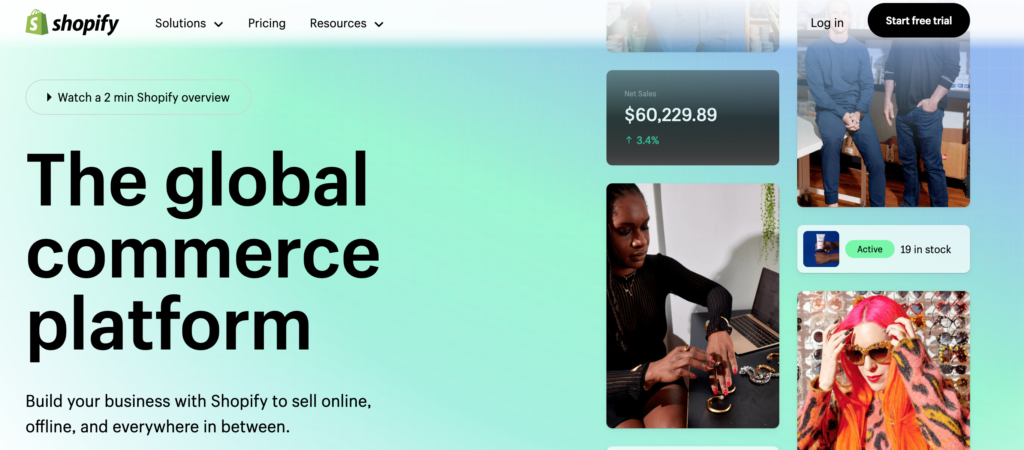
Shopify is the biggest and most popular ecommerce platform. There are many factors that have catapulted Shopify to the top of the charts: Its user friendly interface (for both merchants and customers), robust features and functions, a massive app ecosystem for integrations and expanding the functionalities of your online store, a wide range of highly customisable templates curated for fashion and the apparel business, etc.
Shopify makes running an online clothing store a breeze with its cutting edge inventory management and payment processing features.
Shopify has crucial integrations for social commerce enabling you to sell your products on Instagram, Facebook and other social media and social commerce platforms. You can start your online store with Shopify for as low as $25.5 per month.
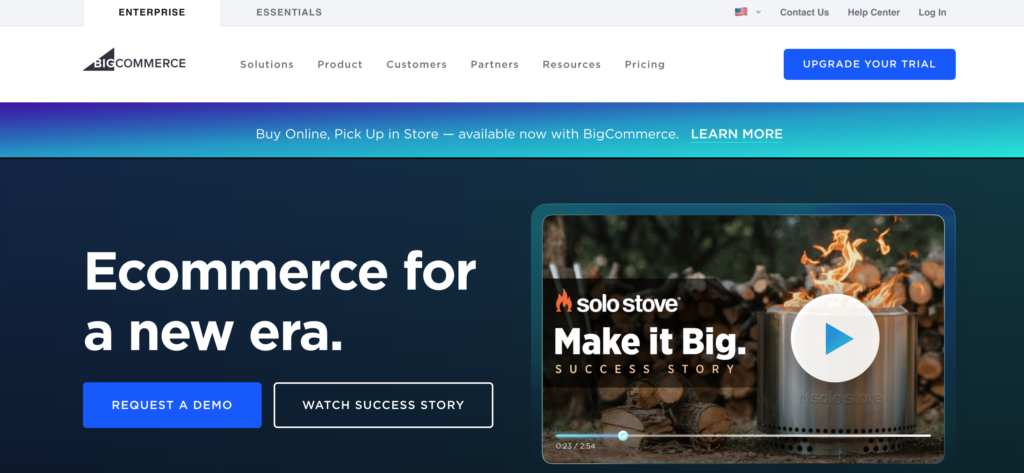
Bigcommerce is another big name in the ecommerce space. This ecommerce platform is focused on online stores with massive inventories and are looking to scale their online stores.
BigCommerce platform offers a generous range of high end and highly customisable apparel themes.
The platform also offers in-built marketing tools and seamless integrations that make it easy to expand the functionalities of your online store beyond the basic setup. Biocommerce has critical integrations for selling your products on social media platforms such as Facebook and Instagram.
The platform also offers Search Engine Optimisation capabilities that enhance the visibility of your online store and search engines, increasing your traffic and sales prospects. BigCommerce plans start from $39 per month paid monthly and $29 per month paid annually.
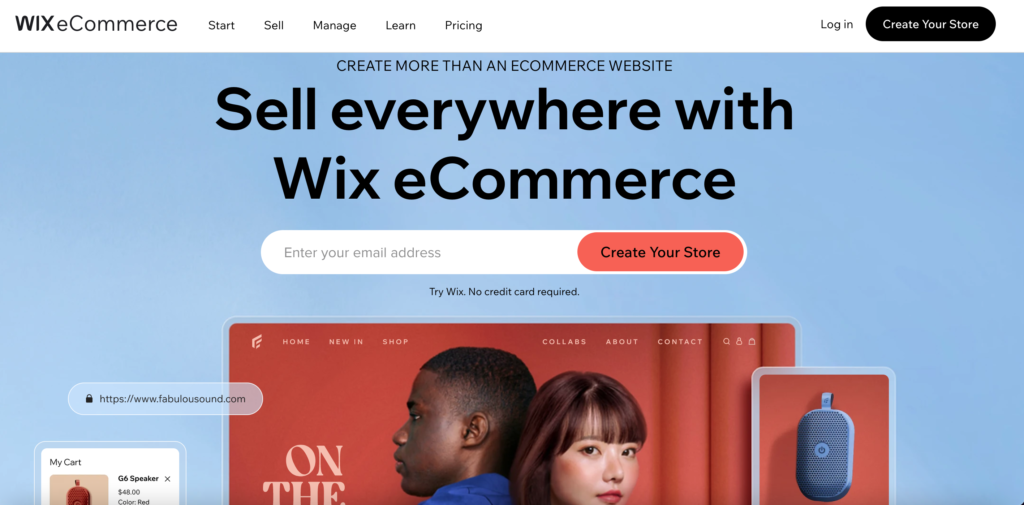
If you want something cheaper than the pricing range of the top ecommerce platforms ( Shopify and BigCommerce) then Wix is a platform you can consider. For about $17 per month you can get started with Wix’s mature and solid ecommerce platform.
Wix offers a user-friendly drag and drop interface that makes it easy to build a professional high end clothing store. The platform also offers a good range of templates and apps to extend the look and feel as well as the functionalities of your online clothing store.
Wix Versus Shopify
While Shopify’s themes are all mobile responsive, some of Wix‘s themes are not mobile friendly.
Shopify also offers detailed sales reports under the Advanced package with Wix doesn’t not have such a feature. Shopify also offers a free slogan maker, terms and conditions generator as well as gift card capability offers. These are crucial features in an ecommerce platform.
Also, while Wix has 50 payment gateways options, Shopify has over 100, including Shopify‘s own proprietary ShopPay payment gateway. Wix has a product limit of up to 5000 while Shopify has no limit on how many products you can upload.
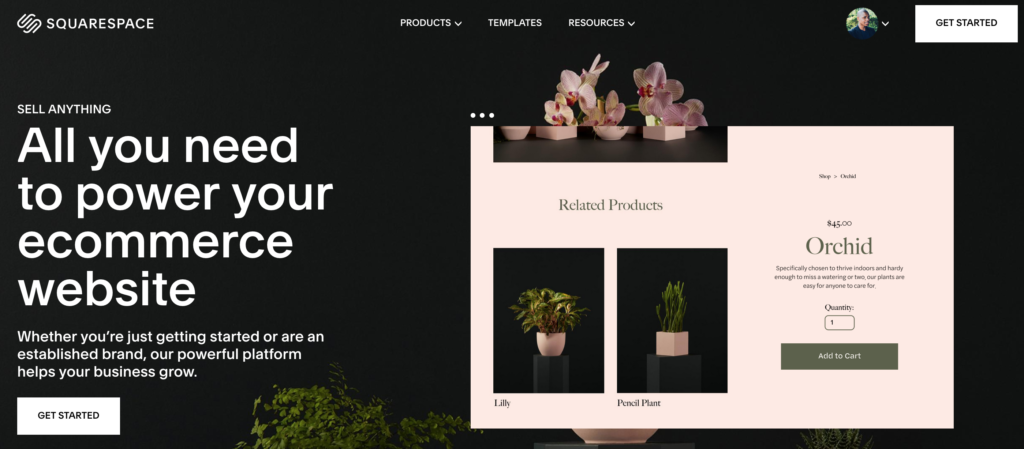
Squarespace is also coming good on the ranks of solid ecommerce platforms. The platform stands out for its elegant and modern templates. While the platform is not solely focused on ecommerce, the platform offers solid and seamless ecommerce functions, features and templates.
The platform has great tools for setting up your product catalogue, inventory management and payment processing. Squarespace ecommerce plans start from $16 per month paid monthly and $23 per month paid annually.
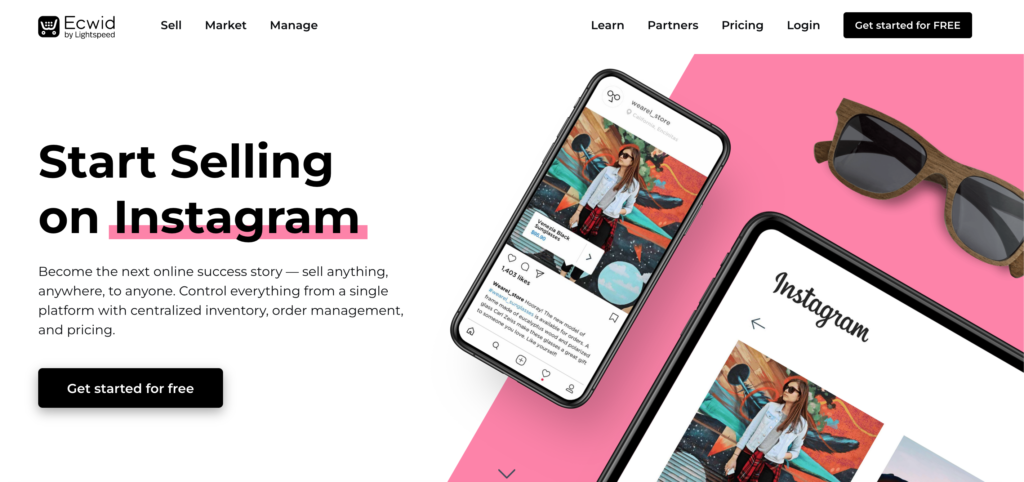
Ecwid is another top player to consider in the ecommerce bloc. The platform enables you to create a professional ecommerce store that runs on this platform (connected to your domain) or can be embedded in your website or even social media platforms.
With Ecwid you will have access to robust integrations and product management, secure payment options as well as mobile responsive templates. Plans on Ecwid start from $19 per month paid monthly or $14.08 per month paid annually.
A Note on WooCommerce as Free Option
The WooCommerce Free plugin is another popular option for starting an online clothing store. The down side with WooCommerce is that while getting the basic plugin free is free, you will need to pay for things like online clothing store website design, SSL, payment gateway, etc.
When you start considering the other stuff you need to do and pay for to get your online store set up and fully functional, platforms like Shopify are better than WooCommerce because they offer everything you need to get your store running and fully functional off the shelf.
The advantage of leveraging powerful ecommerce platforms such as Shopify and BigCommerce is that you won’t have to deal with the technical intricacies of integrating your online store with payment gateways, making your online store mobile friendly and securing your online store.
Online clothing stores created on platforms like Shopify come as a complete suite, a fully-fledged, fully functional and secure online store with multiple payment gateway options off the shelf. If you are building your own online store website you will need to get a developer to ensure that all these components are set up and functioning as expected.
Creating and Setting up Your Online Clothing Store
Design and customisation
To set up a high end clothing online store, choose a theme that matches your brand colors. Customise the design to match your brand. Add your logo and make use of high quality images for your store design as well as for your product catalogue.
Make sure your online store has a simple and well-structured navigation menu that shoppers can easily click through to explore your store categories and drill down to each product.
Now comes the part where you need to select your curated product range for your online store.
You need to research suitable online drop shipping platforms that offer relevant products for your niche. Some of the best clothing suppliers are: AliExpress, Alibaba, SaleHoo, WorldWide Brands, Doba, Sunrise Wholesale, Wholesale2b, Spocket, etc.
Remember to include as many payment gateway options as possible to cater to customers from different geographies considering some payment gateways don’t work in certain countries or states.
Provide contact support and make sure that customers can always contact you easily when and if they need help. Including testimonials and reviews will also ramp up the credibility and trust scores of your store.
User Experience Enhancements
Also, consider enabling social media sharing, set up a search bar for easy product or product category lookup, Also consider optimising the load speed of your website. Your customers will get frustrated and leave if they are made to wait for too long for your online pages to load. Also make use of clear and persuasive calls to action (CTAs) to encourage sale bound interaction.
Tips On Finding Reliable Drop Shipping Suppliers With Quality Clothing Products
It’s important to exercise due diligence in identifying suppliers for drop shipping clothing business. Many people have gotten scammed or have had their expectations let down because of neglecting this crucial thing.
Research Evaluate Suppliers
Due diligence in sourcing clothing suppliers for online stores includes researching and evaluating suppliers.
Check for reputation, track record and credibility. Try to answer questions like who owns the platforms, is their information publicly available, What are the reviews on TrustPilot and other review platforms indicating, Do these have a traceable location and contacts?
Communicate with Suppliers
Also communicate with your potential suppliers. This way you get to evaluate their responsiveness, work ethic and customer service. Ask questions about their product range, pricing and shipping.
Crucial to this step is requesting product samples to assess quality before committing to a partnership. Pay particular attention to the quality of the fabric, durability, stitching and overall craftsmanship.
You then need to evaluate the product catalogue and see if it offers a satisfactory range of product options, variations (colors, style, size, gender, etc). Also check if the supplier is compliant with all necessary regulations such as industry standards and certifications.
It is also helpful to solicit recommendations and referrals as well as to attend apparel related trade shows and exhibitions.
Marketing and Promoting Your Store
You need to quality traffic coming to your website. These are the leads you have for your online clothing business. To get traffic you need to build a comprehensive omni-channel marketing strategy.
Leverage search Engine optimisation (SEO), content marketing and social media marketing to drum up awareness about your shop and drive targeted traffic that can convert to sales.
You can make use of social media listening tools to get granular insights from social media engagements to get data on what customers are looking for and analyse your brand mentions for business development and decision making.
Conclusion
Below is a summary of what we have covered in this guide:
Summary and Overview
Remember what we mentioned earlier: running a successful online clothing store is a process and not an event.
As such you need to continuously evaluate your business model and dynamics based on data: pivot and adapt where needs be. This will ensure not only the survival but the growth of your online clothing store business.
There you have it. With the information above you can start your own online clothing store today and claim your stake in the blooming ecommerce industry.

